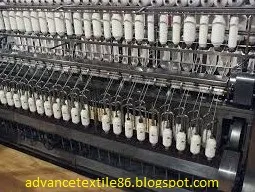Ring frame
Ring
frame is the machine where the final draft is done and finally, yarn is
produced. The cost per spindle for ring spinning is higher. In the states,
where the cotton staple was cheap, the additional labor costs of running mules
could be absorbed, but Lancashire had to pay shipping costs. The critical factor was the availability of labor when skilled labor was scarce then the ring became advantageous.
Working Process
A
ring frame was made by pressing cast iron and later steel. There are spindles
on each side of the frame, at the top are their draughting rollers and at the
top is a creel loading the roving bobbins. Roving (unspun thread) goes down
from the bobbins to the draughting rollers. Here the back roller steadied the
incoming thread, while the front rollers rotated faster, pulling the roving out
and making the fibers more parallel. The rollers are individually adjustable,
originally by means of levers and weights. The attenuated roving now passes
through a thread guide that is adjusted to be centered above the spindle. The
thread guides are on a thread rail that allows their broken threads to be
hinged out of the way for doffing or piecing. The attenuated roving passes down
to the spindle assembly, where it is threaded through a small D ring called the
traveler. The traveler moves along the ring. This is the name given to the ring
frame. From here the thread is attached to the existing thread on the spindle.
 |
| Ring frame |
The main objects of the ring frame
The
objects of the ring frame are below-
1.
To draft the roving fed to the ring frame.
2.
To improve the strength of the fiber strand by twisting.
3.
To wind up the resulting yarn on a bobbin.
4.
To build up the yarn on a bobbin in the form of a suitable for storage,
transportation, and processing.
Major operations of the ring frame machine
1.
Creeling: The process, drawn sliver is introduced to the draft zone from the
sliver can manually.
2.
Drafting: The process, to reduce the weight per unit length by drafting i.e,
passes of sliver through three or four pairs of the roller of different speeds.
3.
Twisting: Twisting is a process that makes a turn within the fiber of the drafted
material to hold them together.
4.
Winding: The roving or too upright bobbin in a particular manner to wound so
that it can be used in the next machine easily.
5.
Building: In the process of building, the roving is wound in the full length of the
bobbin in such a form that will facilitate handling, transfer, and feeding to
the ring frame.
6.
Doffing: Doffing is to replace an empty bobbin at the place of the fully wound
bobbin.








0 Comments